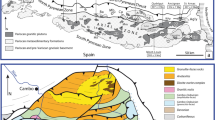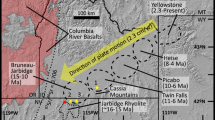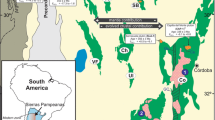Abstract
Preservation of high-temperature mineral isotopic compositions is necessary for successful high-temperature isotopic thermometry. Other requirements include large fractionations between constituent minerals, well-calibrated equilibria, carefully designed sampling strategies and data handling techniques that quantitatively account for retrograde exchange. Here, we apply isotopic thermometry and data handling techniques to calculate and contrast mineral-pair apparent temperature data and observed closure temperature data (T c-observed) (cf. Farquhar et al. 1993) for the very high temperature (>900°C), dry granulites of the Taltson Magmatic Zone of Northwestern Canada and the Napier Complex of Enderby Land, Antarctica. The isotopic compositions of garnet grains from both terrains reflect high temperature conditions (>950°C) and point to this mineral as an excellent candidate for isotopic thermometry. The isotopic compositions of quartz, pyroxene, ilmenite and magnetite indicate that they equilibrated to lower temperature conditions (<900°C) due to faster rates of oxygen diffusion in these minerals, possibly enhanced by exsolution and ductile deformation, compared with garnet. Our temperature data for garnet and pyroxene are ≈200°C higher than is possible to explain by existing “wet” diffusion data, but is consistent with “dry” diffusion data, suggesting that the extremely dry nature of these rocks may have played a significant role in the preservation of high-temperature isotopic compositions. Both quartz and magnetite exhibit subgrain features, indicative of ductile deformation. Quartz-magnetite temperatures from the Napier complex are similar to those inferred for a late (D3) deformation and are lower than those predicted by “dry” diffusion data. We infer that the quartz-magnetite isotopic fractionations reflect deformation-enhanced exchange that accompanied D3. Garnet in these same samples did not undergo ductile deformation and did not exchange oxygen with coexisiting phases during cooling. This may reflect strain partitioning between less easily deformed, low abundance garnet and more easily deformed matrix quartz and magnetite. The resistance of garnet to ductile deformation in these rocks is a second reason why garnet is suitable for isotopic thermometry.
Similar content being viewed by others
Author information
Authors and Affiliations
Additional information
Received: 6 February 1996 / Accepted: 25 April 1996
Rights and permissions
About this article
Cite this article
Farquhar, J., Chacko, T. & Ellis, D. Preservation of oxygen isotope compositions in granulites from Northwestern Canada and Enderby Land, Antarctica: implications for high-temperature isotopic thermometry. Contrib Mineral Petrol 125, 213–224 (1996). https://doi.org/10.1007/s004100050217
Issue Date:
DOI: https://doi.org/10.1007/s004100050217




